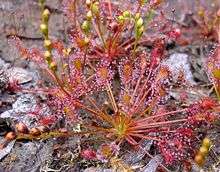Drosera intermedia
| Drosera intermedia | |
|---|---|
 | |
| Scientific classification | |
| Kingdom: | Plantae |
| (unranked): | Angiosperms |
| (unranked): | Eudicots |
| (unranked): | Core eudicots |
| Order: | Caryophyllales |
| Family: | Droseraceae |
| Genus: | Drosera |
| Species: | D. intermedia |
| Binomial name | |
| Drosera intermedia Hayne, 1800 | |

Drosera intermedia, commonly known as the oblong-leaved sundew,[1] spoonleaf sundew,[2] or spatulate leaved sundew, is an insectivorous plant species belonging to the sundew genus. It is a temperate or tropical species native to Europe, southeastern Canada, the eastern half of the United States, Cuba and northern South America.
Morphology
Drosera intermedia is a perennial herb which forms a semi-erect stemless rosette of spatulate leaves up to 10 cm tall. Plants in temperate regions undergo dormancy during which they form a winter resting bud called a hibernaculum.
As is typical for sundews, the leaf blades are densely covered with stalked mucilagenous glands which secrete a sugary nectar to attract insects. These then become ensnared by the mucilage and, unless they are strong enough to escape, are suffocated or die from exhaustion. The plant then secretes digestive enzymes from sessile glands and later absorbs the resulting nutrient solution to supplement the poor mineral nutrition of the plants natural environment.
Drosera intermedia blooms from June through August, forming up to 15 cm. tall inflorescences bearing 3-8 white flowers. Fertilized ovaries swell to form egg-shaped dehiscent seed capsules which bear numerous tiny seeds.
Distribution and habitat
Drosera intermedia is one of the most widely distributed species in the genus, and one of only three Drosera species native to Europe (the others are D. rotundifolia and D. anglica). It is also found in eastern North America, Cuba, and northern South America. The Cuban and South American forms are tropical and do not form hibernacula in the winter.
Drosera intermedia grows in sunny, but constantly moist habitats including bogs, fens,[3] wet sandy shorelines[4] and wet meadows. Since it is carnivorous, it is able to occupy relatively infertile habitats including wet sand and peat. It is a relatively weak competitor, and so is excluded from more fertile sites by competition from canopy-forming perennials.[5] It can survive high water periods as buried seeds, and then re-establish when water levels fall.[6]
References
- ↑ "BSBI List 2007". Botanical Society of Britain and Ireland. Archived from the original (xls) on 2015-02-25. Retrieved 2014-10-17.
- ↑ "Drosera intermedia". Natural Resources Conservation Service PLANTS Database. USDA. Retrieved 18 January 2016.
- ↑ Godwin, K. S., Shallenberger, J., Leopold, D. J., and Bedford, B. L. 2002. Linking landscape properties to local hydrogeologic gradients and plant species occurrence in New York fens: a hydrogeologic setting (HGS) framework. Wetlands 22:722–37.
- ↑ Keddy, P.A. 1981. Vegetation with Atlantic coastal plain affinities in Axe Lake, near Georgian Bay, Ontario. Canadian Field Naturalist 95: 241-248.
- ↑ Wilson, S. D. and P.A. Keddy. 1986. Species competitive ability and position along a natural stress/disturbance gradient. Ecology 67:1236-1242.
- ↑ Keddy, P.A. and A. A. Reznicek. 1982. The role of seed banks in the persistence of Ontario's coastal plain flora. American Journal of Botany 69:13-22.
Further reading
- L. Diels: Droseraceae, 1906, 135 pages. (The only monograph of the family Droseraceae to date.)
- Barthlott, Wilhelm; Porembski, Stefan; Seine, Rüdiger; Theisen, Inge: Karnivoren, Stuttgart, 2004, ISBN 3-8001-4144-2
- Darwin, Charles; Insectivorous Plants (London: John Murray, 1875, 462 pages) LCCN 04-1280; Replica reprints (Scotland: Langford Press, 2002, 462 pages) ISBN 1-904078-04-4; Non-Replica reprints (New York: New York University Press, 1990, 345 pages) ISBN 978-0-8147-1822-3; Project Gutenberg online edition at https://www.gutenberg.org/etext/5765
External links
| Wikimedia Commons has media related to Drosera intermedia. |